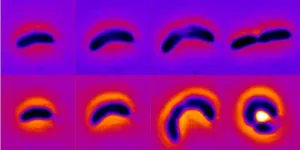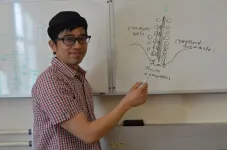Radiation Oncology trials using PET with FDG uptake among NSCLC patients
Research presented at IASLC 2020 World Conference on Lung Cancer Singapore
2021-01-30
(Press-News.org) (Singapore--January 29, 2021 9:35 a.m. SPT/January 28, 2021 8:35 p.m. EST)--Two radiation oncology trials presented at the IALSC World Conference on Lung Cancer Singapore highlight how some researchers are exploring use of higher radiation boost doses to only PET-positive regions in locally-advanced non-small cell lung cancer (NSCLC). A previous large RTOG phase III trial revealed that the unform delivery of a high dose to the entire tumor led to poorer survival.
In one study, Prof. Feng-Ming (Spring) Kong, Case Western Reserve University School of Medicine, in Cleveland, Ohio presented the results of a multicenter trial which aimed to determine whether adaptive isotoxic radiation dose escalation to mid-treatment FDG-PET provides superior local tumor control compared to a standard uniform dose of 60 Gy in patients with stage III NSCLC.
Prof. Kong and the research centers involved in the trials enrolled 138 patients with stage III NSCLC who were medically fit for concurrent chemoradiation. The patients were randomly assigned by a 1:2 ratio to standard (60 Gy) arm or to an adaptive-therapy arm, with dose individualized to 20 Gy mean lung dose (MLD), and adapted to residual tumor on the mid-treatment FDG-PET/CT. All patients had FDG-PET performed around 40 Gy mid-treatment, and radiation therapy was delivered in 30 daily fractions (Fx).
Of 138 patients enrolled between February 2012 and March 2017, 127 were eligible and analyzable, with 43 and 84 patients in the standard and adaptive arms, respectively, with a minimum follow-up of 3.7 and 3.4 years for surviving patients, also respectively.
The adaptive arm consisted of an initial plan of 2.2 Gy/Fx for 21 Fx followed by an adaptive radiation therapy boost to mid-treatment FDG-PET target using a variable prescription of 2.2-3.8 Gy/Fx for the final 9 Fx. The primary endpoint of this report was 2-year local-regional tumor progression free (LRPF), with inclusion of overall and in-field LRPF, assessed independently and blindly by radiologists.
There were no significant differences in lung, esophagus, and heart toxicities, though the adaptive arm had numerically higher mean doses of these organs at risk. The 2-year overall LRPF rates were 59.5% (95% CI: 37.9, 75.7) on the standard arm, and 54.6% (95% CI: 39.9, 67.0) on the adaptive arm. The median LRPF time was 27.5 months (95% CI: 14.3, not reached) on the standard arm and 28.4 months (95% CI: 19.1, not reached) on the adaptive arm. There were no significant differences in overall survival, progression-free survival, or lung cancer-specific survival between the two arms, according to the presentation by Dr. Kong.
"This is the first randomized trial that demonstrated the feasibility and safety of performing biologically adaptive radiation therapy escalation in a multicenter setting in patients with stage III NSCLC. This preliminary analysis did not show an improvement in overall local regional tumor control," Dr. Kong reported.
In the second study, Dr. Saskia Cooke, The Netherlands Cancer Institute in Amsterdam, Netherlands, reports on local and regional failure in the phase II PET-Boost trial (NCT01024829). In this study, patients with stage II-III non-small cell lung cancer (NSCLC) were treated with hypofractionated dose escalation to either the primary tumor as a whole (Arm A) or the high fluorodeoxyglucose (FDG)-uptake region inside the PT (> 50% SUVmax; Arm B).
The trial randomly assigned 107 patients--82% had stage III disease and most patients (72%) received concurrent chemoradiotherapy. In Arms A and B, median gross tumor volume (GTV) for the primary tumor was 100 and 115 cm3, respectively; median GTV for the involved lymph nodes was 18 and 20 cm3, respectively. Median fraction dose was 3.25 Gy to planning target volume (PTV) to the entire primary tumor and 3.50 Gy to PTV 50% SUVmax, resulting in total planned physical dose of 78.0 and 84.0 Gy, in 24 fractions. Median overall treatment time was 34 days in both arms, and median follow-up for CT scans in central review was 12.6 months.
In a previous report, the authors revealed that the primary tumor was non-measurable on follow-up in 27% of patients [Cooke S, 2020]. Of the 12 patients in Arm A who experienced locoregional failure, 2 had local failure (LF) without regional failure (RF) and 9 had RF without LF. Of the 15 patients in Arm B, 4 had LF without RF and 10 had RF without LF. In Arms A and B, respectively, the 2-year cumulative incidence of LF was 11% and 18%, and 28% and 25% for RF. The authors concluded that "dose escalation to the whole PT or 50% SUVmax in patients with NSCLC led to excellent local control rates in both treatment arms". However, few patients were evaluable for assessment of local failure at 2-years, grade 5 toxicity rates was previously reported to be 16% [van Diessen J, 2018], with 3-year OS rates of only 37% in armA and 33% in armB, respectively.
INFORMATION:
About the IASLC:
The International Association for the Study of Lung Cancer (IASLC) is the only global organization dedicated solely to the study of lung cancer and other thoracic malignancies. Founded in 1974, the association's membership includes nearly 7,500 lung cancer specialists across all disciplines in over 100 countries, forming a global network working together to conquer lung and thoracic cancers worldwide. The association also publishes the Journal of Thoracic Oncology, the primary educational and informational publication for topics relevant to the prevention, detection, diagnosis, and treatment of all thoracic malignancies. Visit http://www.iaslc.org for more information.
About the WCLC:
The WCLC is the world's largest meeting dedicated to lung cancer and other thoracic malignancies, attracting more nearly 7,500 researchers, physicians and specialists from more than 100 countries. The goal is to increase awareness, collaboration and understanding of lung cancer, and to help participants implement the latest developments across the globe. The conference will cover a wide range of disciplines and unveil several research studies and clinical trial results. For more information, visit wclc2020.iaslc.org.
ELSE PRESS RELEASES FROM THIS DATE:
2021-01-30
(Singapore Embargoed for 7:23pm EST on January 29, 2021 to coincide with publication in the Journal of Clinical Oncology) -- Adding ipilimumab to pembrolizumab does not improve efficacy and is associated with greater toxicity than pembrolizumab alone as first-line therapy for metastatic non-small cell lung cancer (NSCLC) for patients with a PD-L1 tumor proportion score of greater than or equal to 50% and no targetable EGFR or ALK aberrations, according to research presented today at the International Association for the Study of Lung Cancer's World Conference on Lung Cancer.
The research was presented ...
2021-01-29
New research led by Carnegie Mellon University Assistant Professor of Physics Shiladitya Banerjee demonstrates how certain types of bacteria can adapt to long-term exposure to antibiotics by changing their shape. The work was published this month in the journal Nature Physics.
Adaptation is a fundamental biological process driving organisms to change their traits and behavior to better fit their environment, whether it be the famed diversity of finches observed by pioneering biologist Charles Darwin or the many varieties of bacteria that humans coexist with. While antibiotics have long helped people prevent and cure bacterial infections, many species of bacteria have increasingly been able to adapt to ...
2021-01-29
School closures during COVID-19 have decreased access to school meals, which is likely to increase the risk for food insecurity among children in Maryland, according to a new report issued by researchers at the University of Maryland School of Medicine (UMSOM). The number of meals served to school-age children during the first three months of the pandemic dropped by 58 percent, compared to the number of free or reduced-price meals served the previous spring. As a result, thousands of children across the state were placed at increased risk of food insecurity, with many likely experiencing the health ramifications ...
2021-01-29
Boulder, Colo., USA: GSA's dynamic online journal, Geosphere, posts articles online regularly. Topics for articles posted for Geosphere this month include feldspar recycling in Yosemite National Park; the Ragged Mountain Fault, Alaska; the Khao Khwang Fold and Thrust Belt, Thailand; the northern Sierra Nevada; and the Queen Charlotte Fault.
Feldspar recycling across magma mush bodies during the voluminous Half Dome and Cathedral Peak stages of the Tuolumne intrusive complex, Yosemite National Park, California, USA
Louis F. Oppenheim; Valbone Memeti; Calvin G. Barnes; Melissa Chambers; Joachim Krause ...
Abstract: Incremental pluton growth can produce sheeted complexes with no magma-magma interaction or large, dynamic magma bodies communicating via crystal and melt exchanges, depending ...
2021-01-29
Washington, DC — Blood pressure that remains elevated over of time — known as chronic hypertension — has been linked to heart disease, which is the leading cause of death in the United States. Recent research has shown that persistent high blood pressure may also increase the risk for stroke and overall mortality. Yet, only about 1 in 4 adults with chronic hypertension have their condition under control, according to the Centers for Disease Control and Prevention.
In a new study to be presented today at the Society for Maternal-Fetal Medicine's (SMFM) annual meeting, The Pregnancy Meeting™, researchers from the University of Pittsburgh will unveil findings that suggest that women who develop high blood pressure during pregnancy and who continue ...
2021-01-29
News reports indicate COVID-19 vaccines are not getting out soon enough nor in adequate supplies to most regions, but there may be a larger underlying problem than shortages. A University of California, Davis, study found that more than a third of people nationwide are either unlikely or at least hesitant to get a COVID-19 vaccine when it becomes available to them.
The results are from public polling of more than 800 English-speaking adults nationwide in a study published online earlier this month in the journal Vaccine.
"Our research indicates that vaccine uptake will be suboptimal ... with 14.8 percent of respondents being unlikely to get vaccinated ...
2021-01-29
WOODS HOLE, Mass. -- The most powerful substance in the human brain for neuronal communication is glutamate. It is by far the most abundant, and it's implicated in all kinds of operations. Among the most amazing is the slow restructuring of neural networks due to learning and memory acquisition, a process called synaptic plasticity. Glutamate is also of deep clinical interest: After stroke or brain injury and in neurodegenerative disease, glutamate can accumulate to toxic levels outside of neurons and damage or kill them.
Shigeki Watanabe of Johns Hopkins University School of Medicine, a familiar face at the Marine Biological Laboratory (MBL) as a faculty member and researcher, is hot on the ...
2021-01-29
RIVERSIDE, Calif. -- When we step on the car brake upon seeing a red traffic light ahead, a sequence of events unfolds in the brain at lightning speed.
The image of the traffic light is transferred from our eyes to the visual cortex, which, in turn, communicates to the premotor cortex -- a section of the brain involved in preparing and executing limb movements. A signal is then sent to our foot to step on the brake. However, brain region that helps the body go from "seeing" to "stepping" is still a mystery, frustrating neuroscientists and psychologists.
To unpack this "black box," a team of neuroscientists at the University of California, Riverside, has ...
2021-01-29
A new report combining forecasting and expert prediction data, predicts that 125,000 lives could be saved by the end of 2021 if 50% or more of the U.S. population initiated COVID vaccination by March 1, 2021.
"Meta and consensus forecast of COVID-19 targets," developed by Thomas McAndrew, a computational scientist and faculty member at Lehigh University's College of Health, and colleagues, incorporates data from experts and trained forecasters, combining their predictions into a single consensus forecast. In addition McAndrew and his team produce a metaforecast, which is a combination of an ensemble of computational models and their consensus forecast.
In addition to predictions related to the impact of vaccinations, ...
2021-01-29
Researchers at Linköping University, Sweden, have developed a proton trap that makes organic electronic ion pumps more precise when delivering drugs. The new technique may reduce drug side effects, and in the long term, ion pumps may help patients with symptoms of neurological diseases for which effective treatments are not available. The results have been published in Science Advances.
Approximately 6% of the world's population suffer from neurological diseases such as epilepsy, Parkinson's disease, and chronic pain. However, currently available drug delivery methods - mainly tablets and injections - place the drug in locations where it is not required. This can lead to side effects ...
LAST 30 PRESS RELEASES:
[Press-News.org] Radiation Oncology trials using PET with FDG uptake among NSCLC patients
Research presented at IASLC 2020 World Conference on Lung Cancer Singapore




